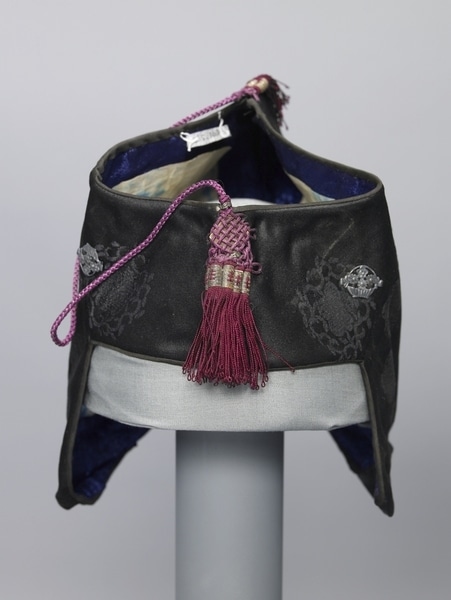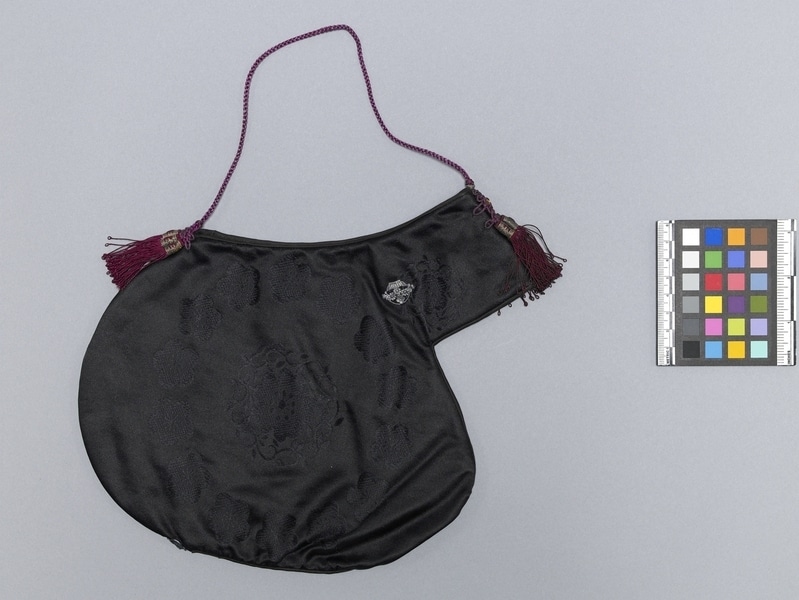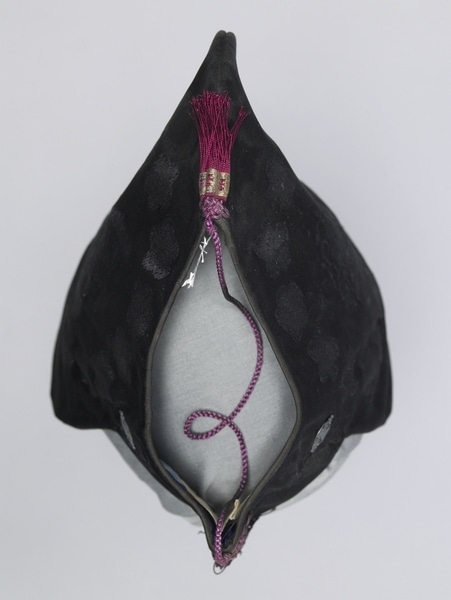Open-top Hat Item Number: Ed1.287 from the MOA: University of British Columbia



Description
Cap of black silk damask with a flower and vines at the centre on each side, surrounded with a circle of five-petalled flowers, and with a smaller flower and vine motif on each side of the forehead. The cap is made of two halves joined at a centre seam from front to back, except for the opening at the top, round when worn. This opening and the forehead area are edged with narrow piping. The edge of the cap is straight across the forehead, but then is cut at a right angle so that it covers the ears. The lower edge forms a circle from the right angle to the top opening. The outer fabric is folded under at the ears and threaded on a cord. The cap is lined with blue-purple rayon damask with floral designs. A purple silk cord extends loosely across the top opening, attached at the centre front and back. At the back are suspended three purple tassels wrapped in silver thread. At the centre front is a complex knot design in purple cord, and five purple tassels. At each side above the right angle is attached a silver-coloured metal ornament in the shape of a basket of flowers. At the end of the back seam is attached an ornament of the same metal in the shape of a bat or cicada. Pieces of white paper are pasted to the inside at both sides, and inside the forehead area.
History Of Use
Satin was not used in Korea until the 20th century, when it was probably imported from Japan or China. Such caps were worn by women of the official “Yangban” class before 1930. They are now being used again by women for decorative purposes on special holidays. They were worn for warmth in the winter, but the top opening prevented the wearer from getting too warm. Some had a cord in the lower edge which allowed the wearer to pull the cap tightly against her face to keep warm. Such caps normally were made of black satin on the outside, but lined with cotton to absorb perspiration. Those made for young girls were more highly decorated with tassels and gold stamps. They had ornaments sewn on the front and back that could be of gold, silver, jade, or red jade, and they usually had Chinese characters on them expressing wishes for happiness, long life, fortune, and many sons. Those for older women were simpler, and had a cord and tassels made of a darker colour, such as purple. Finely-sewn caps were likely to have been made in workshops, although they could be made at home. The gold stamp work, when present, was done by masters in workshops. The metal ornaments and silk cord with tassels might have been purchased in a market.
Specific Techniques
The sewing was done by hand.
Iconographic Meaning
Bat is a symbol of wealth. Cicada is a symbol of a hardy mindset, nobility, having a true mind, and having the ability always to revive. The purple cord and tassels indicate that this cap was for a middle-aged woman.
Item History
- Made in Korea between 1920 and 1930
- Owned by Hi Soon Kim before June 21, 1983
- Received from Hi Soon Kim (Seller) and Museum of Anthropology Shop Volunteers (Funding source) on June 21, 1983
What
Who
- Culture
- Korean
- Previous Owner
- Hi Soon Kim
- Received from
- Hi Soon Kim (Seller) and Museum of Anthropology Shop Volunteers (Funding source)
Where
- Holding Institution
- MOA: University of British Columbia
- Made in
- Korea
When
- Creation Date
- between 1920 and 1930
- Ownership Date
- before June 21, 1983
- Acquisition Date
- on June 21, 1983
Other
- Item Classes
- textiles
- Condition
- good
- Accession Number
- 0894/0004